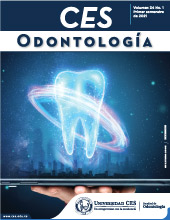Use of bufferized dental anesthetics in dental surgery
DOI:
https://doi.org/10.21615/cesodon.34.1.4Keywords:
Sodium bicarbonate, Carticaine, Anesthesia, Local, nerve block, dentistryAbstract
Introduction and objective: The addition of epinephrine to the anesthetic solution reduces the pH of the solution to a range between 2.9 and 4.4.
The acidity of the anesthetic may delay onset and contribute to injection pain. Objective: to determine the intensity of pain during a mandibular third molar surgery after using buffered 4% articaine with epinephrine 1:100000 in the inferior alveolar nerve block with buccal infiltration. Materials and methods: an observational and descriptive clinical study was performed. The buffered solution was alkalinized with 8.4% sodium bicarbonate with a ratio of 9:1, using a hand-mixing methodology, the sample were patients who required a mandibular third molar surgery. After standardizing the anesthetic technique, it was used the inferior alveolar nerve block followed by buccal infiltration. Results: 32 patients (20 female - 62.5% and 12 male - 37.5%), with an average age of 21.12 years (mean ± standard deviation [SD]: 21.12 ± 3.61) were admitted to the study. When assessing the pain puncture and during the injection, 94% of patients classified it as mild pain according to VAS. When evaluating the latency period, the average time was less than two minutes and the perioral soft tissue anesthesia was 62%. Only a small percentage of patients required complementary anesthesia. Conclusion: buffered 4% of articaine with epinephrine in the inferior alveolar nerve block with buccal infiltration significantly decreased onset time, injection pain and need for complementary anesthesia in third molar surgery.
Downloads
References
Malamed SF. Handbook of Local Anesthesia, 7th ed. St.Louis: Mosby-Year Book; 2019.
Allegretti CE, Sampaio RM, Horliana AC, Armonia PL, Rocha RG, Tortamano IP. Anesthetic Efficacy in Irreversible Pulpitis: A Randomized Clinical Trial. Braz Dent J 2016 27(4):381-386.
Tanaka E, Yoshida K, Kawaai H, Yamazaki S. Lidocaine concentration in oral tissue by the addition of epinephrine. Anesth Prog 2016 63(1):17-24.
Malamed SF, Hersh E, Poorsattar S, Falkel M. Faster onset and more comfortable injection with alkalinized 2% lidocaine with epinephrine 1:100,000. Compend Contin Educ Dent 2013 34(1):1-11.
Malamed SF, Falkel M. Advances in local anesthetics: pH buffering and dissolved CO2. Dent Today. 2012 May 31(5):88-93.
Malamed SF, Falkel M. Buffered local anesthetics: the importance of pH and CO2. SAAD Dig. 2013 Jan 29:9-17.
Malamed SF, Hersh E, Poorsattar S, Falkel M. Faster onset and more comfortable injection with alkalinized 2% lidocaine with epinephrine 1:100,000. Compend Contin Educ Dent 2013 34(1):10-20.
Guo J, Yin K, Roges R, Enciso R. Efficacy of sodium bicarbonate buffered versus non-buffered lidocaine with epinephrine in inferior alveolar nerve block: A meta-analysis. J Dent Anesth Pain Med 2018 18(3):129–142.
Chopra R, Jindal G, Sachdev V, Sandhu M. Double-Blind Crossover Study to Compare Pain Experience During Inferior Alveolar Nerve Block Administration Using Buffered Two Percent Lidocaine in Children. Pediatr Dent. 2016 38:25–29.
Onpharma Sodium Bicarbonate Inj., 8.4% USP Neutralizing Additive Solution [package insert]. Carson City, NV: Onpharma Co; 2017. http://www.onpharma.com/pdf/Onpharma_Sodium%20Bicarbonate_Additive_Solution_Package_Insert.pdf. Accessed June 20, 2019.
US Dept of Health and Human Services. 510(k) approval letters. Silver Spring, MD: Food and Drug Administration; January 8, 2015. https://www.accessdata.fda.gov/cdrh_docs/pdf14/K143757.pdf. Accessed June 20, 2019.
Anutra Medical Receives 510k Approval and Launches New Dental Syringe to Market. Triangle Park, NC: Anutra Medical; January 8, 2015. http://anutramedical.com/wp-content/uploads/2015/04/Anutra-Medical-Receives-510k-Approval-and-Launches-New-Dental-Product.pdf. Accessed June 20, 2019.
Goodchild JH, Donaldson M. Comparing the pH change of local anesthetic solutions using two chairside buffering techniques. Compend Contin Educ Dent 2016 37(5):e6-e12.
Bartlett G, Mansoor J. Articaine buccal infiltration vs lidocaine inferior dental block – a review of the literatura. Br Dent J 2016 220 (3):117-120.
Rogers B.S, Botero T.M, McDonald N.J, Gardner R.J, Peters M.C. Efficacy of articaine versus lidocaine as a supplemental buccal infiltration in mandibular molars with irreversible pulpitis: a prospective, randomized, double-blind study. J Endod 2014 40(6):753-758.
Da Silva-Junior G.P, de Almeida Souza L.M, Groppo F.C. Comparison of Articaine and Lidocaine for Buccal Infiltration After Inferior Alveolar Nerve Block for Intraoperative Pain Control During Impacted Mandibular Third Molar Surgery. Anesth Prog 2017 64(2):80-84.
Malamed SF, Falkel M. Buffered local anesthetics: the importance of pH and CO2. SAAD Dig. 2013 29:9-17.
Kashyap VM, Desai R, Reddy PB, Menon S. Effect of alkalinisation of lignocaine for intraoral nerve block on pain during injection, and speed of onset of anaesthesia. Br J Oral Maxillofac Surg 2011 Dec 49(8):e72-75.
Kurien RS, Goswami M, Singh S. Comparative evaluation of anesthetic efficacy of warm, buffered and conventional 2% lignocaine for the success of inferior alveolar nerve block (IANB) in mandibular primary molars: A randomized controlled clinical trial. J Dent Res Dent Clin Dent Prospect 2018 12(2):102-109.
Malamed SF, Hersh E, Poorsattar S, Falkel M. Faster onset and more comfortable injection with alkalinized 2% lidocaine with epinephrine 1:100,000. Compend Contin Educ Dent 2013 34(1):1-11.
Whitcomb M, Drum M, Reader A, Nusstein J, Beck M. A prospective, randomized, double-blind study of the anesthetic efficacy of sodium bicarbonate buffered 2% lidocaine with 1:100,000 epinephrine in inferior alveolar nerve blocks. Anesth Prog 2010 57(2):59-66.
Shurtz R, Nusstein J, Reader A, Drum M, Fowler S, Beck M. Buffered 4% Articaine as a Primary Buccal Infiltration of the Mandibular First Molar: A Prospective, Randomized, Double-blind Study. J Endod 2015 41:1403–1407.
Gazal G, Alharbi R, Fareed WM, Omar E, Alolayan AB, Al-Zoubi H, Alnazzawi AA. Comparison of onset anesthesia time and injection discomfort of 4% articaine and 2% mepivacaine during teeth extractions. Saudi J Anaesth 2017 Apr-Jun 11(2):152-157.
Guo J, Yin K, Roges R, Enciso R. Efficacy of sodium bicarbonate buffered versus non-buffered lidocaine with epinephrine in inferior alveolar nerve block: A meta-analysis. J Dent Anesth Pain Med 2018 18(3):129–142.
Downloads
Published
How to Cite
Issue
Section
License
Copyright (c) 2021 CES Odontología

This work is licensed under a Creative Commons Attribution-NonCommercial-ShareAlike 4.0 International License.
| Article metrics | |
|---|---|
| Abstract views | |
| Galley vies | |
| PDF Views | |
| HTML views | |
| Other views | |



